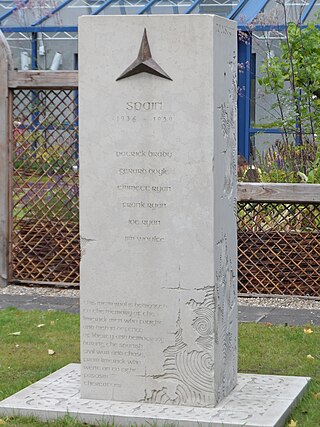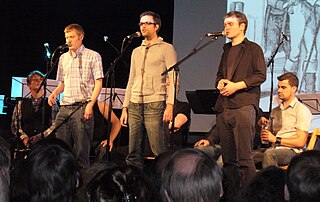Related Research Articles

The Royal Welch Fusiliers (Welsh: Ffiwsilwyr Brenhinol Cymreig) was a line infantry regiment of the British Army, and part of the Prince of Wales's Division, that was founded in 1689; shortly after the Glorious Revolution. In 1702, it was designated a fusilier regiment and became the Welch Regiment of Fusiliers; the prefix "Royal" was added in 1713, then confirmed in 1714 when George I named it the Prince of Wales's Own Royal Regiment of Welsh Fusiliers. In 1751, after reforms that standardised the naming and numbering of regiments, it became the 23rd Regiment of Foot (Royal Welsh Fuzileers). In 1881, the final title of the regiment was adopted.

Gandesa is the capital of the comarca of Terra Alta, in the province of Tarragona, Catalonia, Spain.

The Mackenzie–Papineau Battalion was a Canadian military unit that volunteered to fight with the XV International Brigade on the Republican side in the Spanish Civil War. Except for France, no other country had a greater proportion of its population volunteer in Spain as did Canada. The Canadian soldiers were engaged in some of the fiercest battles of 1937-38 and suffered heavy casualties.

John Leak, VC was an Australian recipient of the Victoria Cross, the highest award for gallantry in battle that could be awarded at that time to a member of the Australian armed forces. Leak enlisted in the Australian Imperial Force in early 1915, and served with the 9th Battalion in the Gallipoli Campaign during the First World War. Evacuated suffering from dysentery, Leak rejoined his battalion after it had been withdrawn to Egypt. Along with his unit, he transferred to the Western Front in France and Belgium, where he participated in the Battle of Pozières in July 1916. He was awarded the Victoria Cross for his actions during the battle. The following month he was seriously wounded in the Battle of Mouquet Farm.

The Connolly Column was the name given to a group of Irish republican socialist volunteers who fought for the Second Spanish Republic in the International Brigades during the Spanish Civil War. They were named after James Connolly, the executed leader of the Irish Citizen Army. They were a company-strength unit of the XV International Brigade, which also included the US, British and Latin American battalions in Spain. The name is now retroactively applied to all Irish volunteers who fought for the Spanish Republic.

William Frederick Longstaff was an Australian painter and war artist best known for his works commemorating those who died in the First World War.

The Spanish Civil War lasted from July 17, 1936 to April 1, 1939. While both sides in the Spanish Civil War attracted participants from Ireland, the majority sided with the Nationalist faction.

Robert Hale Merriman was an American doctoral student who fought with the Republican forces in Spain during the Spanish Civil War. He was killed while commanding the Abraham Lincoln Battalion of the International Brigades.

Irish Socialist volunteers in the Spanish Civil War describes a grouping of IRA members and Irish Socialists who fought in support of the cause of the Second Republic during the Spanish Civil War. These volunteers were taken from both Irish Republican and Unionist political backgrounds but were bonded through a Socialist and anti-clerical political philosophy. Many of the Irish Socialist volunteers who went to Spain later became known as the Connolly Column.

Milton Wolff was an American veteran of the Spanish Civil War, the last commander of the Lincoln Battalion of XV International Brigade, and a prominent communist.

Edward Francis Lynch was a soldier in the Australian Imperial Force who saw action in the First World War on the Western Front between 1916 and 1919.

Lewis Clive was a British rower who won a gold medal in the 1932 Summer Olympics. He volunteered to fight for the Republicans in the Spanish Civil War and was killed in action.

The 3rd Light Horse Brigade was a mounted infantry brigade of the Australian Imperial Force (AIF), which served in the Middle Eastern theatre of World War I. The brigade was initially formed as a part-time militia formation in the early 1900s in Victoria. In 1914, the brigade was re-constituted as part of the AIF. The brigade first saw action while serving with the Australian and New Zealand Army Corps during the Gallipoli campaign where they were noted for their attack during the Battle of the Nek. After being withdrawn to Egypt in February 1916 they were involved in the Sinai and Palestine Campaign until the end of the war. They were attached to a number of different formations being part of the Anzac Mounted Division in March 1916 and the Australian Mounted Division in June 1917, who they remained with until the end of the war. After the war, the AIF light horse regiments were demobilised and disbanded; however, the brigade briefly existed as a part-time militia formation in New South Wales until 1921 when its regiments were reorganised into cavalry brigades.

The 4th Light Horse Brigade was a mounted infantry brigade of the Australian Imperial Force (AIF) serving in the Middle Eastern theatre of World War I. The brigade was initially formed as a part-time militia formation in the early 1900s in Victoria and Tasmania. After the outbreak of World War I, the brigade was raised as a volunteer formation within the AIF in March 1915 and shipped to Egypt and was broken up in August 1915 to provide dismounted reinforcements to other light horse formations already deployed to Gallipoli. Reformed in February 1917, the brigade was assigned to the Imperial Mounted Division, which formed part of the Egyptian Expeditionary Force, and in June 1917 transferred to the Australian Mounted Division, where it served in the Sinai and Palestine Campaign until the end of the war. After the war, the AIF light horse regiments were demobilised and disbanded; however, the brigade briefly existed as a part-time militia formation in New South Wales until 1921 when its regiments were reorganised into cavalry brigades.

The Young'uns are an English folk group from Stockton, County Durham, England, who won the BBC Radio 2 Folk Awards "Best Group" award in 2015 and 2016 and "Best Album" for Strangers in 2018. They specialise in singing unaccompanied, performing traditional folk songs and sea shanties, contemporary folk songs such as Billy Bragg's 1985 song "Between the Wars" and Sydney Carter's 1981 song "Sing John Ball", and original works including "You Won’t Find Me on Benefits Street" and "The Battle of Stockton". They champion the folk music of the Northeast of England, where they are from, celebrating local history and performing songs by local songwriters such as Graeme Miles.

Robert Andrew Doyle was a communist activist and soldier from Ireland. He was active in two armed conflicts; the Spanish Civil War as a member of the International Brigades and the Second World War as a member of the British Empire's Merchant Navy.
"Jamie Foyers" is a song by the folk singer and songwriter Ewan MacColl. In The Essential Ewan MacColl Songbook, Peggy Seeger wrote that the song was written in the period 1937-1939 but could not give an exact year. The song was not copyrighted until 1963 by Stormking Music.
James Maley was a Scottish communist, political activist, Spanish Civil War combatant and World War II veteran.

Australian official war artists are those who have been expressly employed by either the Australian War Memorial (AWM) or the Army Military History Section. These artist soldiers depicted some aspect of war through art; this might be a pictorial record or it might commemorate how war shapes lives.

Charles William Duncan Hutchison was a British-Ghanaian anti-fascist, soldier, and ambulance driver most famous for being the only Black-British member of the International Brigades during the Spanish Civil War. In Spain he was one of the youngest, one of the longest serving, and one of the first English-speaking volunteers. Citing his experiences as a man of colour and his childhood spent in an orphanage, Hutchison was an ardent anti-fascist and was involved in helping organise anti-fascist activists that took part in the Battle of Cable Street. Immediately joining the British military following Britain's declaration of war against Nazi Germany, Hutchison served the British Army between 1939 and 1946. During this time, he took part in the Dunkirk evacuation, the Italian campaign, North African campaign, and the liberation of Bergen-Belsen concentration camp. Hutchison spent almost 10 years engaged in battles against various fascist forces throughout Europe, before starting a family in 1947 and living the rest of his life quietly in South England. Despite his achievements, the details of his life were not fully revealed to historians until 2019, following a history project kickstarted by London school children.
References
- ↑ Cooney, Sean (4 February 2019). "A working-class hero: how a scruffy teenager fought fascism". The Guardian . Retrieved 4 February 2019.
- ↑ "Longstaff, John Edward (Spanish Civil War)". Imperial War Museum . Retrieved 7 November 2022.
- ↑ "Longstaff, John Edward (Second World War)". Imperial War Museum . Retrieved 7 November 2022.
- ↑ Kelly, Mike (13 February 2020). "Theatre review: Folk stars The Young'uns captivate Newcastle audience". nechronicle. Retrieved 14 February 2020.
- ↑ "Sheffield show depicts amazing life of 1930s fighter against fascism, Johnny Longstaff". Sheffieldtelegraph.co.uk. Archived from the original on 5 February 2019. Retrieved 4 February 2019.